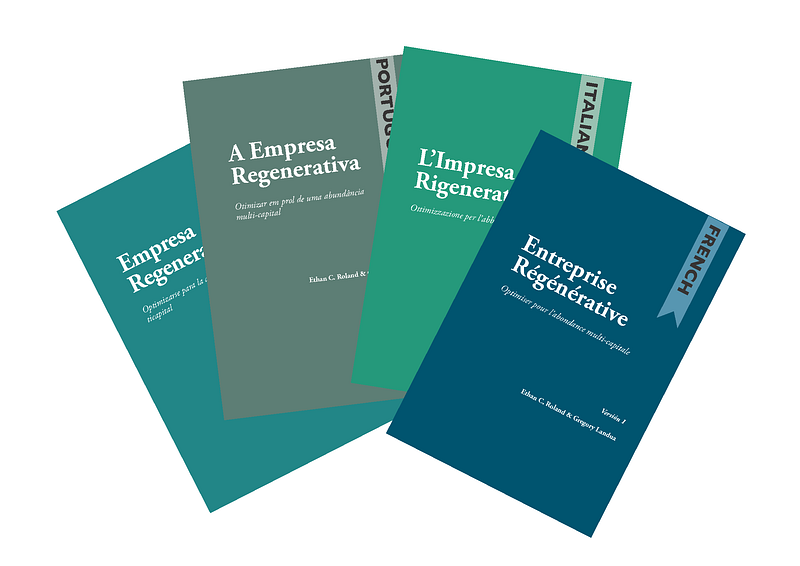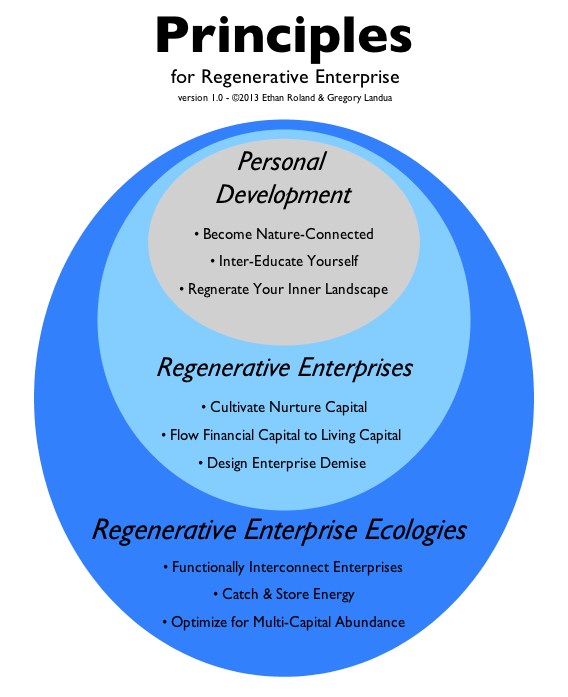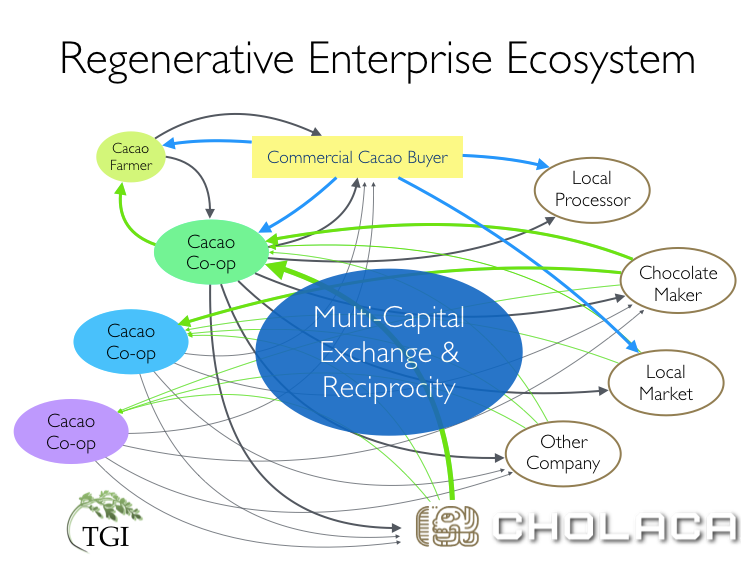This month we released translations of our book Regenerative Enterprise into 4 new languages. Potential readership increased by 986 million people; the area in which readers might live increased by 3 billion hectares or 21% of the earth’s landmass. 
When we wrote the book in 2013, the terms “Regenerative Enterprise” and “Regenerative Business” were almost unheard of. These days the term is hot, appearing everywhere from SOCAP to Sustainable Brands to the Harvard Business Review.
On this 4-year anniversary, we are pausing to reflect on the evolution of the ideas presented in our book. We highlight one area that has stayed largely the same, explore four areas where our thinking has changed significantly, and conclude with specific learnings about how to create Regenerative Enterprise Ecosystems.
What Has Remained the Same
The unique and essential message of our work remains unchanged:

The Eight Forms of Capital still exist. Financial capital is still the dominant global currency. The continual pursuit of Financial-capital-only profits perpetuates the highly destructive extraction of value from Living and Cultural capitals.
Increasing and evolving the health of whole living systems requires nurturing all forms of capital. To do so, Regenerative Businesses must generate multi-capital profits — especially to cultivate the four “Nurture Capitals”: Living, Social, Spiritual, and Cultural.
It is extremely difficult for any single company to accomplish this alone. Therefore, businesses must mimic natural systems, designing and operating Regenerative Enterprise Ecosystems that integrate and optimize for multiple forms of capital as a whole network.
What Has Changed
Our thinking, and the field we are all working in, has evolved and grown significantly in each of the following four areas.
Change 1. Uplifted Ground
We can feel a palpable shift in the global business community. The “soil” of the worldwide enterprise is enriched and enlivened. Companies are focusing on ecological and social wellbeing, from massive brands like Unilever to multitudes of small and medium social enterprises and purpose-driven businesses. Investment has also grown: Socially responsible and impact investing increased 347% from 2010–2016 (Assets in SRI grew from $2.51 trillion to $8.72 trillion; Source: US SIF)
At the same time, our Regenerative Enterprise thinking has been adopted, engaged, and evolved around the world. Eight Forms of Capital has been featured in the Regenerative Capitalism work of the Capital Institute, by international firm Frog’s “Designmind” blog, at an International Development Design Summit in Brazil, as the organizing framework for the book Prosper!, in Slow Money Chapters around the US, by the GoodWork Institute, and has been taught at institutions of higher education from Columbia to the University of California.
More than ever before, the business world is ripe and ready for Regenerative Enterprise.
Change 2. Connected to Source
We originally learned the term “Regenerative” from the Permaculture movement and the landscape design thinking of John Tillman Lyle. Unfortunately, we used the term as it’s used in many current contexts: functional, flat, and lacking potential.
It turns out that there is a community of practitioners who have been using and growing the work of Regeneration. Led by author and educator Carol Sanford, the community has pioneered the work of Regenerative Business for over 40 years inside of major companies like Google, Clorox, DuPont, Colgate Palmolive, and Seventh Generation. The work continues through the annual Regenerative Business Summit, hosted by the Carol Sanford Institute and Regenerative Business Alliance.
Since the Regenerative Enterprise was released we have had the opportunity to engage deeply with this community. It thoroughly disrupted our limited understanding of Regeneration, business, and enterprise, as well as our overly mechanistic beliefs about how people and organizations grow.
Working with the Carol Sanford Institute is like stepping out of “flatland” — a cave where everything exists only in a colorless and restricted two dimensions — and into a rich new multi-dimensional world outside of what we thought was possible.
Change 3. Principles & Imperatives
In our book we offer nine principles and three imperatives to help you develop the effectiveness and multi-capital profits of your business:

These principles are excellent. If every business in the world worked by them, we’d be living in a different world. And, we have learned that simply taking someone else’s principles (even really “good” ones) and applying them to your business is not effective or regenerative.
Instead, principles must be generated fresh for each business, from the business itself. Each entrepreneur and each enterprise is thoroughly unique, and can express its uniqueness through developing it’s own set of managing principles. This is similar to the faulty (yet extremely popular) idea of “best practices” — the idea that something that worked for someone somewhere else will necessarily be the “best” approach in your unique situation. It won’t. Blindly adopting “best practices” is the opposite of expressing your own uniqueness — in fact, it squashes creativity and innovation.
The same goes for global imperatives. Working with living systems frameworks like the Eight Forms of Capital, Regenerative Enterprises must articulate their own imperatives. Once clear and fully adopted, unique principles and imperatives are a powerful source of effectiveness for each business to have its desired impact on the world.
Interlude: How to Create Regenerative Enterprise Ecosystems
In the last four years we have designed and grown Regenerative Enterprise Ecosystems around the world. We’ve built them for multi-national corporations, for specific industries (e.g. Regenerative Cacao), and for our own communities (e.g. Finka Aekolado & Cooperativa EcoCacao).
I asked my co-author Gregory Landua to share his thoughts on the strongest forces at play when designing and developing Regenerative Enterprise Ecosystems. Here’s what he said:
The biggest restraints are the interface between modern industrial supply logistics monocultures and the creative polyculture of direct-trade-driven regenerative agriculture.
The economy of scale required for the current monoculture is hard to achieve, but entrepreneurs keep trying. This is not really the pathway towards a regenerative economy.
Pushing against these restraints is the enormous groundswell of people with deep desire to find solutions that address the roots of ecological, social, and economic crises.
How can we reconcile these opposing forces? 
1. Enterprises must have a strong sense of the six streams of Regenerative Business so they can see how to add value to all players in the ecosystem.
2. Businesses should create strong relationships instead of trying to compete on the alienating commodities markets where externalized costs make it impossible to show the true multi-capital damage of “business as usual”.
3. Cultivate reciprocity at the level of the enterprise ecosystem and beyond. This is not possible if everyone is trying to simply extract value from the system. Multi-capital profits require non-linear reciprocity.
Change 4. Beyond the Ecosystem
Building interconnected clusters of businesses that mimic the capacity of natural systems to regenerate the four nurture capitals is important. What has changed in our thinking is that we no longer believe this is enough.
Truly regenerative enterprise ecosystems must take aim at shifting a specific larger system in the world — something larger than themselves, but also concrete — “Optimizing to generate multiple forms of capital” is good, but it is too abstract in to drive strategic business design.
If companies do not clearly and specifically choose which system they want to change (e.g., the criminal justice system, the business education system, the commodities supply system), they will not be effective in generating new potential and possibility in the world.
Focusing on a concrete system to change will help magnetize appropriate businesses to engage with a growing enterprise ecosystem. Regenerative Enterprise Ecosystems must look beyond themselves, and design specific strategies to put their multi-capital profits to work to contribute to larger systemic transformation.

What’s Next?
Invite your Spanish-, French-, Italian-, and Portuguese-speaking contacts to read Regenerative Enterprise. If you haven’t read it yet, get the English version. All the books are available in multiple formats at the Regenerative Enterprise Institute.
Translations: The jump from 1.5 billion English speakers to 2.5 billion potential readers is a big step, but it’s not enough.
Who will translate the ideas into Mandarin? Hindi? Arabic? Russian? Bengali?
Who will design and grow place-sourced locally appropriate Regenerative Enterprise Ecosystems in each bioregion of the earth?
After hearing what’s changing for us… what will you change next?
Get the translations at http://www.regenterprise.com/translations/

